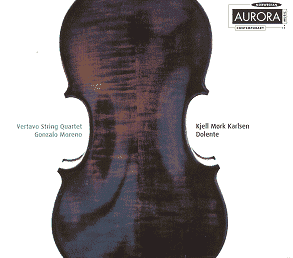Organist, oboe and recorder player, Karlsen is also
a composer with a sizeable body of works to his credit. His large output
includes much choral music, sacred and profane, as well as five symphonies,
several concertos, choral-orchestral works and a great number of chamber
works. His music has been much influenced both by his musical background
and by his performing activities, but also by his close contacts with
Finn Mortensen through whom he approached serial music. Some of his
earlier works, such as the Magnificat 2, the Third Symphony
and the First String Quartet Op.66, bear the imprint of
serialism.
The String Quartet No.1 Op.66, composed
in 1985 and revised ten years later, is the earliest work here. It is
in three movements (Fragmentum, Medium and Fugatum). As
implied by its title, Fragmentum alternates a number of isolated
fragments, outbursts and softer sections, without any real attempt at
development. Medium is a nervous Scherzo. The final Fugatum
is a powerful fugal Finale bringing the piece to an impressive conclusion.
As a whole, the First String Quartet is a serious and substantial work.
The other works in this cross-section are all more
recent and clearly reflect Karlsen’s progress towards renewed simplicity
without really relinquishing his main characteristics. The Violin
Sonata "Mesto" Op.96 of 1990 is also in three movements
(but, curiously enough, the present recording has the first two movements
only): a prologue and an epilogue (not recorded here) framing a central
movement Nostalgi in which Karlsen quotes a traditional Norwegian
tune.
The Sonata Nova Op.101 (1992), for viola
and piano, is a single movement design falling into several clearly
delineated sections. This is a more austere, introspective work well
suited to the warmly lyrical voice of the viola. It also has its moments
of energy and even of violence; and, as a whole, it is a virtuoso work
but also a heartfelt, communicative piece of music, and – to my mind
– a worthwhile addition to the viola’s limited repertoire.
Much of the same could be said about the beautifully
lyrical Sonata Dolorosa Op.108 for cello and piano completed
in 1994. It is also a single movement structure with four contrasted
sections, the last of which is a deeply felt and moving Lento
of great expressive beauty.
The String Quartet No.3 Op.121, completed
in 1998, is thus the most recent piece here. Again, it is a concise
single movement in three sections; and a further example of Karlsen’s
recent, simplified style, though there is nothing minimalist about the
music. The notes’ writer, who knows much better than I do about Karlsen’s
music, mentions that Karlsen’s newly found simplicity is akin to Pärt’s
limited, but expressive techniques. I for one tend to disagree, at least
when judging by what the works recorded here demonstrate. Karlsen’s
music is never as austere as any of Pärt’s.
Excellent performances and recordings, and a worthwhile
selection of Karlsen’s superbly crafted, communicative and basically
lyrical music. Well worth investigating.
Hubert Culot


